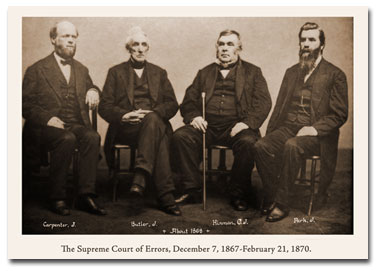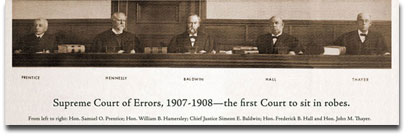
 Significant Connecticut Supreme Court
Cases
Through The Years Significant Connecticut Supreme Court
Cases
Through The Years
Attorney Wesley W. Horton
November 2010
-
Symsbury Case, Kirby 444 (1785) (The first reported New
World case declaring a statute unconstitutional.)
-
Nancy
Jackson v. Bullock, 12 Conn. 38 (1837) (Slave brought to
Connecticut to serve slave-owner’s family freed. Note: In
1837 Connecticut was still a slave state.)
-
Webster v. Town of Harwinton, 32 Conn. 131 (1864) (Towns
have no inherent powers.)
-
In re
Mary Hall, 50 Conn. 131 (1882) (First case in the United
States decided by an appellate court where a woman won the
right to practice law.)
-
State
ex rel. Morris v. Bulkeley, 61 Conn. 287 (1891) (Refusal
to decide who won the 1890 election for Governor.)
-
Norwalk Street Ry. Co.’s Appeal, 69 Conn. 576 (1897)
(Each branch of government has only those powers granted by
the state constitution.)
-
Town
of Windsor v. Whitney, 95 Conn. 357 (1920) (First zoning
case in the United States holding that setting building
lines is not a confiscation of private property.)
-
State
v. Nelson, 126 Conn. 412 (1940) (Connecticut’s
anti-contraception statute is held to be constitutional.)
(Note: This decision eventually led to Griswold v.
Connecticut, 381 U.S. 479 (1965), effectively overruling
Nelson. Griswold led to Roe v. Wade,
410 U.S. 113 (1973).)
-
Horton v. Meskill, 172 Conn. 615 (1977) (Connecticut’s
school finance system forcing town to rely mostly on the
local property tax violated the rights of children in
property-poor towns to an equal educational opportunity.)
-
Sheff
v. O’Neill, 238 Conn. 1 (1996) (De facto racial
segregation in the Hartford metropolitan area public schools
violates the right of children in such towns to an equal
educational opportunity.)
-
Kelo
v. New London, 268 Conn. 1 (2004), affirmed, 545 U.S.
469 (2005) (Condemnation of private property for conveyance
to another private property owner to accomplish a public
purpose is a proper use of the state’s power.)
-
Kerrigan v. Commissioner of Public Health, 289 Conn. 135
(2008) (Gay couples have a state constitutional right to
marry.)
 Where The
Supreme Court Sat Where The
Supreme Court Sat
Attorney Wesley W. Horton
November 2010
The Connecticut Supreme
Court (called the Supreme Court of Errors until 1965) was
created by statute in 1784. From then until 1819, it sat in
June of even-numbered years in the Old State House in Hartford,
and it sat in June of odd-numbered years in a state house that
no longer exists in New Haven.
In 1819, the Supreme
Court began hearing cases also in courthouses in the other six
counties. In New London County, the court sat at New London and
Norwich; in Fairfield County, at Fairfield and Danbury; in
Windham County, at Brooklyn; in Litchfield County, at
Litchfield; in Middlesex Country, at Middletown and Haddam; and
in Tolland County, at Tolland. This system remained essentially
unchanged (except that Bridgeport replaced Fairfield around
1854) until 1866.
From 1866 until 1931,
the Supreme Court sat only in Hartford, New Haven, Bridgeport
and Norwich. (While there were five justices during most of the
nineteenth and twentieth centuries, from 1859-1863 and 1867-1870
there were only four.) From 1878, when the present Capitol was
opened, until 1910, the Supreme Court sat (whenever it sat in
Hartford) in what is now the Old Judiciary Room in the Capitol.
On December 1, 1910, the present Supreme Court building was
opened. It heard its first case in this building on January 3,
1911.
Since 1931, with
occasional one-day-only exceptions, the Supreme Court has sat
only in the building expressly built for it across from the
Capitol in Hartford.
100th Anniversary Home
Page
Attorneys
| Case Look-up | Courts |
Directories |
Educational Resources | E-Services |
Español | FAQs |
Juror
Information | Media |
Opinions | Opportunities |
Self-Help |
Home
Common Legal Words | Contact Us |
Site Map | Website Policies and
Disclaimers
Copyright © 2016,
State of Connecticut Judicial Branch
|



